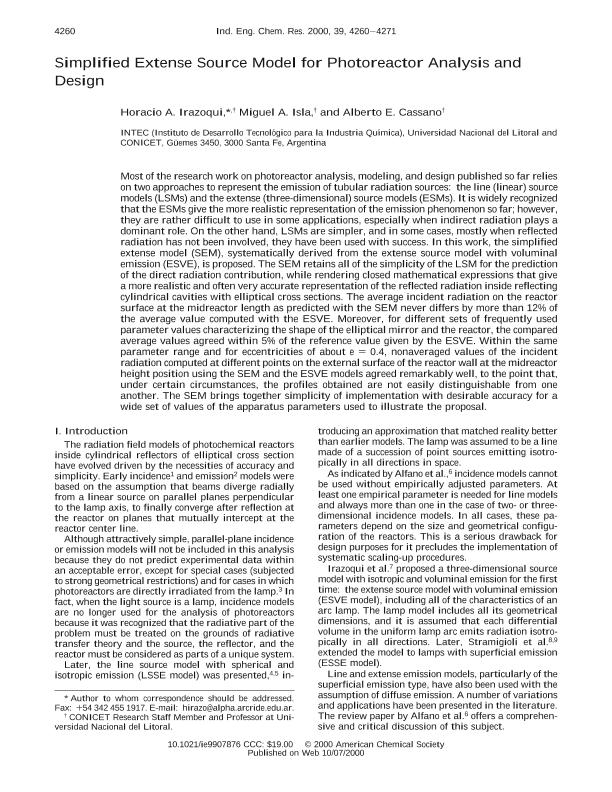Mostrar el registro sencillo del ítem
dc.contributor.author
Irazoqui, Horacio Antonio

dc.contributor.author
Isla, Miguel Angel

dc.contributor.author
Cassano, Alberto Enrique

dc.date.available
2017-11-08T14:18:20Z
dc.date.issued
2000-11
dc.identifier.citation
Irazoqui, Horacio Antonio; Isla, Miguel Angel; Cassano, Alberto Enrique; Simplified Extense Source Model for Photoreactor Analysis and Design”.; American Chemical Society; Industrial & Engineering Chemical Research; 39; 11; 11-2000; 4260-4271
dc.identifier.issn
0888-5885
dc.identifier.uri
http://hdl.handle.net/11336/27806
dc.description.abstract
Most of the research work on photoreactor analysis, modeling, and design published so far relies on two approaches to represent the emission of tubular radiation sources: the line (linear) source models (LSMs) and the extense (three-dimensional) source models (ESMs). It is widely recognized that the ESMs give the more realistic representation of the emission phenomenon so far; however, they are rather difficult to use in some applications, especially when indirect radiation plays a dominant role. On the other hand, LSMs are simpler, and in some cases, mostly when reflected radiation has not been involved, they have been used with success. In this work, the simplified extense model (SEM), systematically derived from the extense source model with voluminal emission (ESVE), is proposed. The SEM retains all of the simplicity of the LSM for the prediction of the direct radiation contribution, while rendering closed mathematical expressions that give a more realistic and often very accurate representation of the reflected radiation inside reflecting cylindrical cavities with elliptical cross sections. The average incident radiation on the reactor surface at the midreactor length as predicted with the SEM never differs by more than 12% of the average value computed with the ESVE. Moreover, for different sets of frequently used parameter values characterizing the shape of the elliptical mirror and the reactor, the compared average values agreed within 5% of the reference value given by the ESVE. Within the same parameter range and for eccentricities of about e = 0.4, nonaveraged values of the incident radiation computed at different points on the external surface of the reactor wall at the midreactor height position using the SEM and the ESVE models agreed remarkably well, to the point that, under certain circumstances, the profiles obtained are not easily distinguishable from one another. The SEM brings together simplicity of implementation with desirable accuracy for a wide set of values of the apparatus parameters used to illustrate the proposal.
dc.format
application/pdf
dc.language.iso
eng
dc.publisher
American Chemical Society

dc.rights
info:eu-repo/semantics/openAccess
dc.rights.uri
https://creativecommons.org/licenses/by-nc-sa/2.5/ar/
dc.subject
Analysis
dc.subject
Model
dc.subject
Photoreactor
dc.subject
Radiation
dc.subject.classification
Otras Ingeniería Química

dc.subject.classification
Ingeniería Química

dc.subject.classification
INGENIERÍAS Y TECNOLOGÍAS

dc.title
Simplified Extense Source Model for Photoreactor Analysis and Design”.
dc.type
info:eu-repo/semantics/article
dc.type
info:ar-repo/semantics/artículo
dc.type
info:eu-repo/semantics/publishedVersion
dc.date.updated
2017-11-03T20:27:30Z
dc.journal.volume
39
dc.journal.number
11
dc.journal.pagination
4260-4271
dc.journal.pais
Estados Unidos

dc.description.fil
Fil: Irazoqui, Horacio Antonio. Consejo Nacional de Investigaciones Científicas y Técnicas. Centro Científico Tecnológico Conicet - Santa Fe. Instituto de Desarrollo Tecnológico para la Industria Química. Universidad Nacional del Litoral. Instituto de Desarrollo Tecnológico para la Industria Química; Argentina
dc.description.fil
Fil: Isla, Miguel Angel. Consejo Nacional de Investigaciones Científicas y Técnicas. Centro Científico Tecnológico Conicet - Santa Fe. Instituto de Desarrollo Tecnológico para la Industria Química. Universidad Nacional del Litoral. Instituto de Desarrollo Tecnológico para la Industria Química; Argentina
dc.description.fil
Fil: Cassano, Alberto Enrique. Consejo Nacional de Investigaciones Científicas y Técnicas. Centro Científico Tecnológico Conicet - Santa Fe. Instituto de Desarrollo Tecnológico para la Industria Química. Universidad Nacional del Litoral. Instituto de Desarrollo Tecnológico para la Industria Química; Argentina
dc.journal.title
Industrial & Engineering Chemical Research

dc.relation.alternativeid
info:eu-repo/semantics/altIdentifier/doi/http://dx.doi.org/10.1021/ie9907876
Archivos asociados
